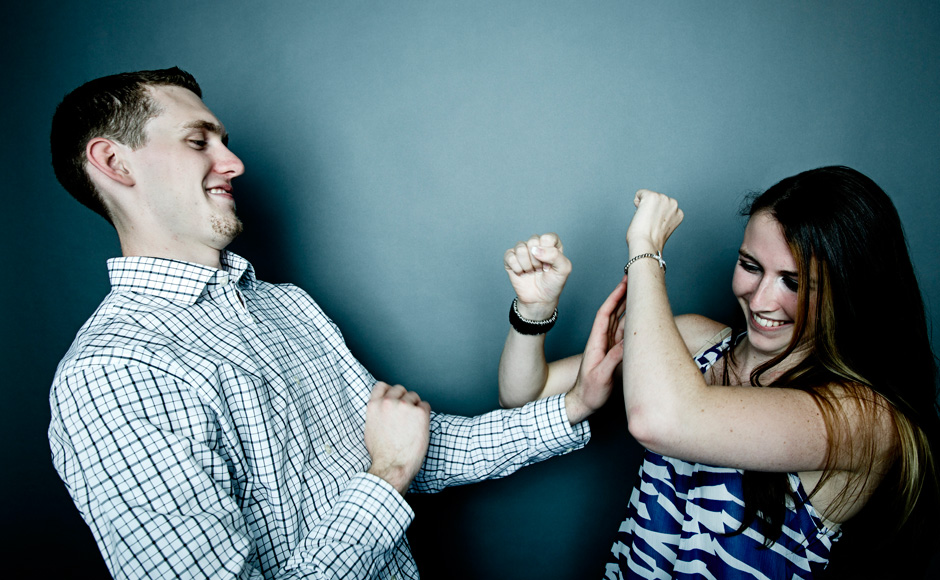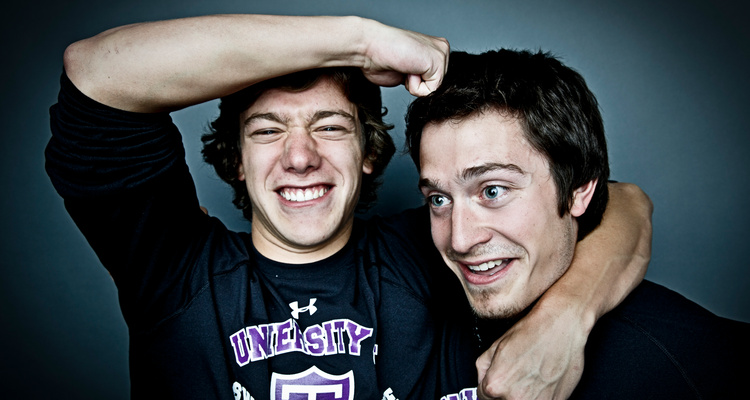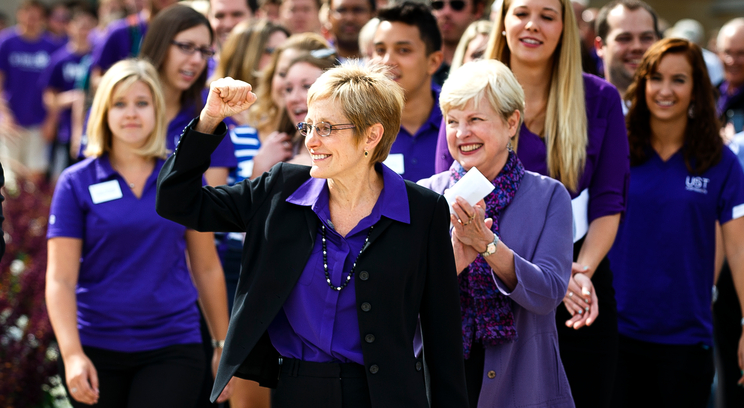Have you ever had one of those déjà vu moments? You’re walking on campus and pass a young woman and think, “Didn’t I just see her in one of my classes?” Or maybe you pass a guy as you leave the dorm, only to see him moments later in line at Scooter’s?
For a moment, you might look around to see if anyone else is seeing what you’re seeing. Chances are, they do. With at least 32 sets of undergraduate twin siblings on campus, the odds are pretty good that it’s not just you. We’re all seeing double.
But the multitude of twosomes should not come as a surprise. Research shows that the number of twins in our world is increasing ... well, more than twofold. According to a 2012 data briefing, the Centers for Disease Control found that the U.S. twin birth rate (number of twins per 1,000 births) rose 76 percent from 1980 through 2009. The ratio of how often twins are born also has made a dramatic change from 1 in 35 babies (1980), to 1 in every 30 (2009).
The increase in twin births may be due to several factors. Women are having children later in life, and expectant mothers are more likely to give birth to twins as they conceive closer to their 30s. Fertility treatments also increase the chance of giving birth to twins, and more and more women are using these treatments to increase the odds and viability of conception. There also is a gene that a woman can inherit that causes her to hyper-ovulate, meaning she’s more likely to release multiple eggs during ovulation. This condition increases the chance of having fraternal twins, which are produced from two separate eggs, but there is no known gene linked to identical – or paternal – twins, which are produced when one egg splits in half.
With more than 64 students sharing a birthday – and often much more – with a sibling on campus, we thought it might be interesting to learn more about their duplicity.

Joe and Lindsey Leonard.

Alison (front) and Kayla Bengtson.
“Gigabow!” Come, again?
Translated in “twin speak,” gigabow means movie. But how would the rest of us know that?
As young children, twins often can be heard talking to each other in a language only they understand. This autonomous language is created and shared between only the two individuals in a set of twins. (Extremely close siblings also can develop their own lingo, but it’s much more common in twins.)
The phenomenon of twins creating their own language is known as idioglossia, but it doesn’t happen among every set. And sadly, there is no single, shared “twin” language that the non- twins among us can study.
For junior Joe Leonard and his sister, senior Lindsey, the “secret language” wasn’t purposely created or practiced. It just came about naturally.
“I didn’t speak English until I was about five years old,” Joe said. “Lindsey used to have to translate for our parents because they couldn’t understand our language.”
“I thought that was how every set of twins spoke,” Lindsey said. “In elementary school, when I met the first set of ‘other’ twins in my life, I asked them what their language was and they looked at me like I was nuts.”
The Institute of General Linguistics found that as many as 40 percent of twins invent their own language. One possible motivation for creating this new vernacular is that the twins may be using each other as models to learn to speak and communicate. They apply meaning to sounds, even if those noises are complete gibberish.
As siblings start school and their vocabulary expands, usually their secret lingo disappears. Though Lindsey and Joe cannot remember most of the words they used as kids, Lindsey believes that having a language no one else could speak gave them a special bond. “It was fun for us. We were each other’s best friend and that just made us closer.”
Double trouble
With junior Alison Bengtson writing scripts and working the camera, and her sister Kayla as the star actress, this media-enthused duo have been creating and starring in their own homemade productions since they were 8 years old. With self-proclaimed theatrical personalities, Alison and Kayla auditioned for a 2004 Disney Channel television sitcom version of the movie “The Parent Trap.” The 1998 Disney remake stars Lindsey Lohan, who played a set of twins who were separated at birth, found each other at a summer camp and then switched lives.

Michelle (left) and Laura Vanney
With red hair like Lohan, Alison and Kayla made it to the final auditions and were one of only a few other sets of twins being considered. But before a final casting decision was made, the Disney Channel decided to produce a different twin-themed show called “The Suite Life of Zack of Cody.”
Despite not getting to play the part of twins who switched lives, Alison and Kayla have executed a couple switcheroos of their own. “Back in high school I used to pretend to be Kayla and once in a while we would switch classes just for the fun of it,” Alison admitted. “I might feel like hanging out with a person in Kayla’s anatomy class, so we’d switch.”
Don’t worry, Alison and Kayla claim that they haven’t switched places in their college courses ... yet. “I think we’re too afraid to switch in college,” Kayla said.
Peas. Pods.
Many twins see college as a time to explore their independence apart from their sibling, but twins who want to attend the same school have different ways of growing as individuals.
As senior engineering majors and roommates, Dalton and Dustin Scherrill see each other every day. “We end up taking a lot of the same classes even though we sign up for them without talking to each other,” said Dalton, who added, “It can get annoying.”
But for four months one semester, they were in different countries: Dalton in Germany and Dustin in Austria. Both brothers saw the physical distance as an opportunity.
“I made it my goal to not let it be known that I was a twin because the individuality was awesome,” Dustin said. “We have the same friends and same hobbies, so it can be hard to become my own person.”
While some twins seek independence, others are wary. When junior Michelle Vanney went to Ecuador for three weeks and sister Laura went to New York, they missed each other – a lot.
“It was pretty hard,” Laura said. “I wanted someone else to be there with me because I’m used to always having Michelle around.”
Laura and Michelle are both education majors, share a love of soccer, wear glasses, work at the same clothing store and often will finish each other’s sentences.
They acknowledge that they have similar interests and lifestyles because ... well, they have been living together their whole lives. “People forget that we are different people,” Laura said. “(They) tend to group us as one, as the ‘twins.’”
Grad school may give them an opportunity to go their own ways – if just for a few years. But Michelle hopes they eventually end up living in the same area.
“We’ve joked about living in houses right next to each other,” she said with a smile. “But we will always be close, so the distance won’t matter.”
If they do end up living in the same neighborhood, the odds are there will be a whole lot of déjà vu ... all over again.







